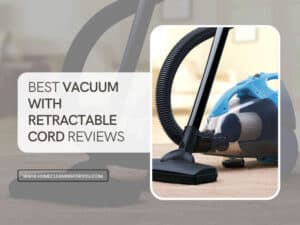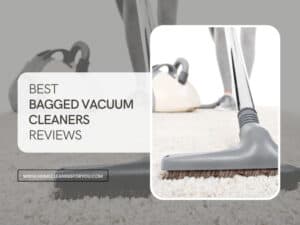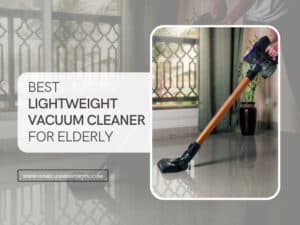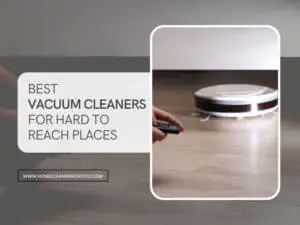6 Instant Ways To Eliminate Those Pesky Vacuum Cleaner Odors
Did you detect a nasty vacuum cleaner smell lingering around your house every time you use it? If this is your case, chances are, a bit of check-up and cleaning is much-needed to eliminate the stench and restore your vacuum’s freshness.

While a vacuum cleaner is primarily used for collecting dirt and debris, these filthy particles can get jammed in the works, causing the unit to stink badly and decrease its efficiency. This situation is most likely to happen in the dust canister, filters, brush roll, and hose.
If you’re all set to eliminate that foul-smelling odor, I’m here to help. In this guideline, you’ll understand the causes and find the best way to remove some of the most common vacuum smells, along with some bonus expert-sourced tips.
So if you’re all ready, roll up your sleeves and get that smell out of your house for good!
How to Get Rid Of Bad Smell In A Vacuum Cleaner?
If you haven’t localized the culprit for the smell or simply don’t have the patience for a detailed inspection, this general guideline will help you tackle any smell emitted from the vacuum.
1. Empty The Bag Or Dust Canister:
Take out the dust bin or bag and empty it to remove all the dirt and debris. Then, add a bit of mild detergent to wash and rinse it under tap water.
2. Clean The Filters:
Detach all the filters from the unit. Gently remove loose debris on the surface and rinse it under a faucet until the water runs clear.
3. Wash The Brush Roll:
Pull out any hair, lint, or visible debris stuck in between the bristles and give it a good cleaning in a sink of soapy water before rinsing clear.
4. Clean The Hose:
Fill a big bucket with tap water and let the water run through the hose multiple rounds. Then, stretch it out to get rid of the excess water before hanging it on the rack.
5. Wipe The Exteriors:
Take a clean, soft cloth or rag and gently wipe the exteriors and underside of the machine. Next, wipe it dry with another cloth or let it air-dry.
6. Reassemble:
After allowing each part adequate time to air-dry, put the machine back together in the correct order, and you’re ready for the next go.
For a visual demonstration from a professional cleaner, here’s how to cure the stinky smell in your vacuum cleaner.
What Causes Your Vacuum To Smell Bad?
There could be several reasons why your vacuum is starting to reek of odors. To get rid of this unpleasant stench, you first need to localize the culprit, which often falls into one of the five main categories as follows.
1. Pet Dander and Hair
Having furry animals around the house might be accounted for why your vacuum is stinky. The hair and dander are smelly once shed from their bodies, let alone when stuck inside the vacuum’s works. If your device smells like feet or dirty socks, this tends to be the main reason.
2. Pet Urine
Besides your pet’s hair-falls, their urine can add an extra dimension to the smell. Whether you vacuum it up right away or not, this liquid has a knack for sticking in their hair long afterward.
The combination of urine and shed hair makes up for a nasty, stinky smell once it gets into the vacuum, which happens to even the best vacuum cleaners for cleaning up cat litter.

3. Mold Build-Up
Whether you use your vacuum to get spilled milk out of your carpet or pick up liquid food from the floors, the unit is often subjected to lots of dirt and liquid, creating the ideal breeding ground for mildew and mold spores.
This happens a lot in the bag and filtration system. If left unattended for too long, you’ll notice a foul-smelling odor from inside the works. To avoid these messy scenarios, you can try to use a wet-dry vac, a device designed to handle liquid spills like a breeze.
4. Excessive Dust and Debris
A poor cleaning and maintenance routine can cause your vacuum to give off a terrible smell around the house. While food crumbs, coffee grind, dust, and other debris are cleared from the floor, these particles can remain in the system.
Not only does this create a strong smell, but it also poses a risk of malfunctions by clogging the machine and affects its durability in the long run.
5. Burnt Belt
If you sense a burning plastic smell coming from your device, chances are, its belt may be burnt. This part is made out of rubber, which allows the brush to roll and pick up debris as it rotates.
If not cleaned at regular intervals, the brush can amass hair, lint, and other particles that interrupt its rotation. This can happen even when you own a vacuum specifically designed for long hair.
As a result, this tends to damage the belt and even get it caught on the brush. A worn-out or overused belt emits an irritating chemical smell and should be replaced ASAP.
What Should I Do When My Vacuum Cleaner Smells Like Dog?
While your furry animal is a loving member of the family, it also stands a chance of causing unpleasant odors in your vacuum. More often than not, this occurs even when your dog is bathed regularly.
Whatever your vacuum’s odor may be and how urgent you are to deodorize it, it’s critical to turn off all controls and disconnect the unit from the socket beforehand.
Given that water and electricity don’t belong together, this safety measure will reduce any risk of electrical shock while performing the maintenance. With that in mind, let’s flick through these simple steps that you can take to quickly fix this stinky problem.
Step 1: Empty The Dust Bin Or Bag
Most of the time, letting too much dirt build up inside of the vacuum’s dust canister or bag is the primary cause for a persisting dog smell. If your vacuum has a dust bin, it’s best to empty it in the trash can and have it thoroughly cleaned after every use.
For a bagged vacuum, you should change the bag as soon as you notice a lingering dog smell. The golden rule is to replace the garbage bag at least every 3 months on a semi-weekly vacuuming schedule, but it’s advisable to check it more frequently to prevent such smells.
Step 2: Clean The Filters
Filters can amass a significant amount of pet dander and debris if left untreated for a long time. Carefully take out the filters and rinse them under regular tap water until the water runs clear.
Otherwise, if your filters are non-washable and showing signs of clogging issues or severe damages, it’s probably time for a much-needed replacement to get rid of the smell.

Step 3: Wash The Brushes
The moisture and dirt that come in contact with the vacuum’s brush can get stuck, causing it to stink and even decrease cleaning efficiency. Once the brush is detached from the device, gently remove loose lint and gently wash it in soapy water before letting it air-dry for at least 24 hours.
Cleaning your vacuum brush roll doesn’t have to be a hard chore to deal with, as long as you know how to do it properly.
Step 4: Check The Hose
If you notice a nasty dog odor along with a minor suction power loss, the problem may lie in the hose. In this case, prepare a bucket of hot water and move the hose around to ensure that the water gets to every nook and cranny of it. Then, hang it over a hose rack or shower rail to dry.
To give your vacuum hose a good wash, be sure to take a look at this short video before getting into the chore.
Step 5: Spice Up Your Vacuum
Once all the parts are entirely dry, you can start putting them back together. Now, to add a pleasant scent to your vacuum and rid of this dog odor for good, you can use some easy-to-find pantry staples like cinnamon, allspice, or rosemary.
Sprinkle some of these scented spice onto the carpet and allow them to sit for up to an hour before vacuuming them up. The mixture will release a fragrance both in the air and inside of the machine.
It’s best that you apply this method on a dark-colored carpet, as dark spices pose a risk of discoloring pale carpets.
What Should I Do When My Vacuum Smells Like Vomit?
Vomit smell is a very distinguishable stench that should be removed as soon as you inspect it. If you live in a big family with lots of kids where accidents happen from time to time, using your vacuum to clean up the mess from the carpet or floors might be the reason why it starts to stink.
The good news is, with a bit of effort and a facemask to avoid making the matter even more complicated, you can give your vacuum a good clean and quickly breeze through this problem.
Step 1: Clean The Filters
When you use your vacuum to take care of wet messes, the filters are most likely to accumulate odor-causing residue from the puke. Thusly, after switching off and unplugging the machine, locate and take the foam, felt, and HEPA filters out for a wash.
Because vacuum filters are easily damaged, you should only rinse them under cold water and set them out to dry afterward. Additionally, take a damp towel or cloth to wipe the area around the filters to lift off any remaining dirt.
Step 2: Wash The Brush
With lots of soft bristles, your vacuum’s brush also needs a check-up when localizing the cause of a vomit smell. If the brush is removable, detach it from the unit and wash it with clean water and a few squirts of a mild disinfectant or baking soda in a pinch.
While you’re at it, take a look at the underside of the unit to eliminate any residual stain or smell from the last time you cleaned up the vomit.
Step 3: Check The Hose
If your vacuum features a suctioning hose for the puke clean-up, it’s a good idea to take your hose out for a good cleaning. Fill a bucket with warm water and let the hose soak in the water while stretching it out.
You can also add some dishwashing detergent if the hose seems to be clogged with heavily ingrained dirt. Then, hang it up to dry on a rack or out in the sun before reinstalling it into the unit.
Step 4: Reassemble The Vacuum
After checking up, cleaning, and allowing these removable parts to dry, you can finally reinsert them back into places for the next go. If you’re unclear of the proper order for this process, make sure to consult your user manual.
What Should I Do When My Vacuum Smells Like Burning?
Like other pieces of machinery, a vacuum cleaner contains multiple components that work together to perform its function. A burnt plastic or chemical smell may indicate that at least one of these parts is severely malfunctioning.
As soon as you notice this major red flag, the most important thing to do is immediately turn the machine off and remove the plug from the outlet. Then, you can try to diagnose the problem yourself following this guideline.
Step 1: Turn Off The Machine
Unlike other stenches, with a burnt rubber smell, you’re dealing with some serious mechanical issues. For your maximum safety, it’s crucial to unplug the machine and turn off its power switch before getting into the chore.
Step 2: Check The Belt
Take a peek underneath, and you’ll easily find the belt located between the motor shaft and the brush roller. If it still remains intact, pull out any carpet fiber, hair, or lint that may be stuck in the belt and stopping the brush from rotating properly.
However, since this belt is made out of rubber, it’s likely to get stretched, worn-out, or broken over time. Though some metal belts are more long-lasting, they still stand a chance of becoming damaged if used for a long time.
If you detect these signs, it may be time for a much-needed belt replacement to get rid of the burning rubber smell. To prevent this issue and save you some headaches down the road, you should replace the belt every year if it’s rubber.
Step 3: Remove Debris Clogs
Physically inspect between the brush roll and the belt for any object that may cause clogging and prevent the brush from spinning properly. These pieces of debris may be string, hair, and grime buildup.
Step 4: Check The Brush Roll
A broken brush roll may be the culprit for the plastic smell that you’re sensing. If the brush has worn out bristles or it’s severely broken due to heavy-duty use and abuse, you’ll want to have it replaced by yourself. Otherwise, it’s best to have it checked by a professional technician.
Step 5: Inspect The Motor
If you’ve checked all the previous parts and the smell still lingers around, the real problem that you’re facing may be a motor malfunction. In this case, you should hand it to an authorized professional for a check-up and repair.
You can clearly see how to tackle a burning vacuum smell problem and replace a belt in this video.
What Should I Do When My Vacuum Smells Like Rotten Eggs?
If your vacuum emits a strong stench that smells like sulfur or rotten eggs, the problem tends to come from the dust canister or garbage bag. While this smell isn’t actually hazardous to your health, its off-putting essence might induce vomiting if not treated as soon as possible.
Step 1: Empty The Dust Canister or Bag
When you use your vacuum to pick up a broken or spilled egg, the residues left behind may leave the machine with a nasty rotten egg smell. Depending on whether your machine is bagged or bagless, empty the dust canister or the garbage bag.

Step 2: Clean The Dust Bin
With a stinky dust bin in hand, fill a sink with lukewarm water and some dishwashing detergent. By giving the canister a deep cleaning, you can sanitize and deodorize it to make sure that the sulfur smell is completely eliminated.
Step 3: Check The Filters
After removing the dust bin, you’ll have easy access to the filters. Take them out and rinse under cool water until the dirt and residues are washed out. In this step, you should also inspect them for wear and damages to make a proper replacement.
Step 4: Call A Repair Professional
Once all the detachable components are dry, reassemble the machine and give it a go. If the rotten smell still lingers, the problem probably comes from its electrical system. In this case, you should immediately unplug the unit and go to a repair professional to fix it.
What Should I Do When My Vacuum Smells Moldy?
When it comes to the musty aroma of mold and mildew, the biggest culprit is the vacuum filters. This occurs when your vacuum picks up dirt and liquid, both of which make up the perfect breeding ground for mold spores.
What’s more, if you refit the filters into the machine while they’re still wet, the residual moisture also contributes to feeding mildew. Thusly, by ridding of these live funguses, you’ll be able to eliminate the moldy smell at the same time.
If you have to tackle wet messes regularly, you should consider getting a wet-dry shop vac for the best assistance. This device excels at cleaning up both dry dirt and liquid with minimal risk of fungus accumulation.
Step 1: Remove The Filters
After performing the first safety measure, which is to disconnect the vacuum from the socket, gently detach the filters from the machine. An outdoor faucet is ideal for tackling moldy filters since this will prevent any chance of the spores spreading in your house.
However, it’s entirely possible to clean the filters in your kitchen or bathroom sink, as long as you handle them with extra caution.
Step 2: Rinse The Filters
Since vacuum filters are often prone to damages, it’s best to lightly wash them thoroughly under regular tap water without any intensive rubbing. If your vacuum has multiple filters, make sure to have them all cleaned.
Step 3: Disinfect The Filters
Unlike other types of dirt, mold and mildew are live funguses, which means plain water may be ineffective in removing them all. In cases like this, you can easily mix up a homemade mold-fighting solution containing hydrogen peroxide or white vinegar.
Otherwise, opt for a commercial mold and mildew cleaner, so you can get the device clean and fungus-free with ease.
Gently scrub one of these ingredients onto the entire filter and wash them again with clean water until you’re satisfied with the final result. Then, put the filters in a well-ventilated place, preferably out in the sun, to let it dry.
Step 4: Clean Other Components
While the filters are mainly accounted for the moldy smell, it’s also important to check other attachments for visible signs of mold spores. Take out and give the dust canister, hose, and brush roll a good cleaning and drying session.
If you’re unclear as to how to properly clean and change vacuum filters when fouling smells appear, this video is definitely a must-watch!
What Should I Do When My Vacuum Smells Like Cat Pee?
If you’ve used your vacuum to clean up your cat’s litter, it may be accounted for the smell that lingers around the house. Another way to explain this situation is that your feline pet is doing undignified things directly on the appliance.
Cat urine smell is quite a difficult stench to remove, especially if left in place to dry for a long time. Therefore, the best way to tackle this strong odor is by acting as fast as the accident happens.
Step 1: Empty and Clean The Dust Bin
Now, if you own a bagged unit, it’s undoubted that at this point, you’ll want to replace the bag with a primed and clean one. With an advanced household bagless vacuum, take out the containment bin and clean it in soapy water to remove the nasty odor.
Step 2: Rinse The Filters
When picking up cat urine, you’re basically cycling particles of pee through the filters into your vacuum, causing the stench to get trapped within the filtration system. Thusly, you should remove the filters and rinse them under clear water.
However, this only applies to vacuum filters that are washable. Otherwise, consider getting a filter replacement to ensure that your machine can run smoothly without emitting odors.
Step 3: Clean The Brush
With this detachable component, you can add equal parts of baking soda, white vinegar, and warm water to create an easy cleaning mixture. Rub it onto the brush roll and lightly scrub to remove any cat urine residue.
Step 4: Rinse The Hose
Add a few squirts of lemon essential oil into a bucket of warm water and rinse the hose thoroughly. In essence, its antibacterial properties excel at freshening your vacuum hose by neutralizing the stinky odor, thusly makes essential oil a great home cleaning remedy.
Next, fill another bucket with water and wash the hose until the smell disappears. When finished, lift both of its ends to drain out excess water before hanging it on a rack to dry.
Step 5: Wipe The Exteriors
If your feline friend has urinated directly on your vacuum cleaner, it’s important to clean up the exteriors. With a vinegar and baking soda solution, take a soft, clean cloth to wipe away all the dirt and moisture that’s remained on the sides and undersides of the machine.
How To Make Vacuum Cleaner Smell Good?
When it comes to maintaining pieces of machinery, prevention is always better than cure. To keep your vacuum smelling fresh all day and stinky odors at bay, here are a few simple remedies that work every time.
1. Baking Soda
As one of the universal deodorizers and efficient floor cleaners at home, baking soda is a favored pantry staple for its ability to absorb odors rather than just masking them. Its cleaning properties work on virtually all types of stenches to give you maximum flexibility.
To freshen up your vacuum, sprinkle a few teaspoons of baking soda on the walls of the dust canister or simply put some in the containment bag.
However, the power of this deodorize also has its downside. According to some cleaning experts, these tiny particles pose a risk of clogging the filters and destroying the electric motor if used improperly or overused for an extended period.
Therefore, rather than vacuuming up baking soda from the floor or carpet, you should only have it sprinkled inside of the containment canister to avoid unwanted damages.
2. Cinnamon
It’s a given that cinnamon is an effective natural cleaning remedy for unwanted odors. The spice has a distinctively dominating yet pleasant fragrance that can mask and take over any lingering smell in your vacuum.
With this easy-to-find spice in hand, all you need to do is place half a teaspoon inside of the dust canister or garbage bag in your unit. Next thing you know, you can take this house chore off the list while being treated to a sweet smell from the machine spreading through the air.
If you happen to run out of cinnamon, other spices that make great alternatives are cloves, nutmeg, and allspice. Make sure to choose an ingredient that suits your taste before you hit the chore.
3. Essential Oils
Adding a little bit of essential oil into your vacuum can benefit you in more than one way. Without a doubt, these fragrances are calming and soothing, especially while you’re spending time cleaning the house.
But more than that, many essential oils are created with anti-fungal and antibacterial properties, allowing them to disinfect the vacuum while adding an extra dimension of smell to it.
Place 5-10 droplets of essential oil into the bag or dust bin before getting into the job. The type of oil is easily variable based on your preference. This could be lavender, vanilla, lemongrass, or thyme, whichever you feel like it.

If you’re wondering how exactly to add essential oil into your vacuum, don’t miss the following video!
4. Commercial Air Freshener for Vacuums
Besides natural homemade remedies, you can also consider a commercial air freshener and deodorizer designed for vacuums. When choosing this product, it’s best to opt for an agent with no harsh or harmful chemicals to make sure that it’s safe to use around your family and pets.
Also, the freshener shouldn’t have a masking fragrance, which is usually toxic and can be harmful to your health.
Place the scented granules or spray directly inside the vacuum bag or containment canister, and you’re good to go. With every pass that you take on the floors, these air fresheners will release a nice smell and kill off any foul odor that you despise.
5. Stick To A Maintenance Schedule
As stated above, the best way to fix a vacuum smell is to prevent it from happening beforehand. The best preventative measure for this situation is to conduct a periodical cleaning routine for your machine.
As a rule of thumb, you’ll need to disassemble and give it a deep cleaning at least every year. But for the detachable parts like brush roll and hose, it’s best to take them out for a quick cleaning every so often.
In addition, you should make sure to empty out the dust canister or bag after every use so that no dirt residue is left to stink inside.
FAQs
Besides the general guidelines for each and every stinky situation, here are a few tips from the professionals so you can get the job done efficiently and with minimal effort.
Additional Advice
In fact, bad vacuum smells occur more often than you might think. Even the most properly maintained devices can emit irritating odors from time to time. Therefore, having this guide in hand will be extra helpful when the situation happens in your daily life.
On a more important note, if you have asthma, allergen, or simply despise whatever dirt you may find while taking apart the machine, it’s best to wear a facemask and gloves.
This doesn’t only ward off potential hazards to your health but also reduces the irritating and nasty smell while you’re at it.
Hopefully, with this step-by-step guideline, any last trace of foul-smelling odor will be eliminated from your vacuum cleaner, giving it a longer lifespan. I really look forward to hearing everything about your experiences with it!








Kevin Jones
Founder & Chief Home Organization Strategist
Expertise
Home Organization & Decluttering, Efficient Cleaning Methods & Stain Removal, Sustainable Cleaning Practices, DIY Home Maintenance & Repairs, Space Optimization & Storage Solutions, Budget-Friendly Home Care Strategies
Education
University of Texas at Austin
Kevin Jones is the Founder and Chief Home Organization Strategist at HomeCleaningForYou.com.
He earned a Bachelor of Science in Interior Design from the University of Texas at Austin, focusing on space planning and sustainable design. Specializing in home organization, decluttering, and budget-friendly home care, he helps homeowners create functional and stylish spaces.
Kevin has been featured in lifestyle publications and has collaborated with eco-friendly brands on home organization solutions. He shares his expertise through DIY guides, workshops, and online tutorials. Passionate about minimalism, he enjoys testing new organization methods and exploring sustainable living ideas.